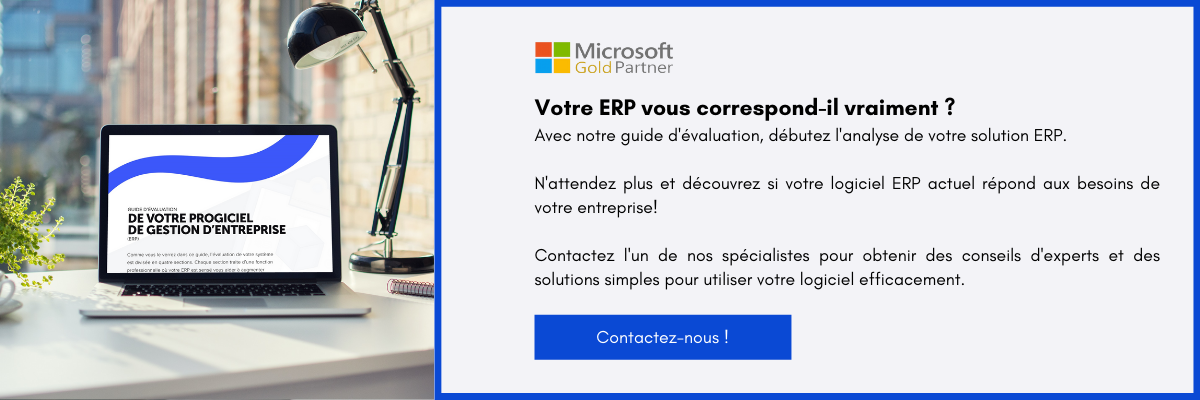L’utilisation d’un logiciel peut améliorer la gestion d'inventaire et favoriser des résultats concrets dès les premiers jours suivant son implantation. Quels sont les 11 avantages associés aux progiciels de gestion intégrée ? Cet article vous apportera toutes les réponses relatives à ce sujet.
.png)
Pourquoi la gestion d'inventaire avec un ERP est un avantage pour développer vos activités ?
Prioriser une politique de proximité avec la clientèle est une stratégie souvent déterminante pour garantir le développement d’une entreprise, société ou organisation. A ce titre, améliorer la gestion d'inventaire est une « étape clé » pour satisfaire chaque client. En effet, comment répondre aux requêtes formulées par vos prospects en sous-entendant une information inexacte ?
Avec un logiciel, la gestion d'inventaire évoque 3 points à considérer :
- La mise à jour en temps réel des informations – permet au service clientèle d’accéder à une base de données fiable et de favoriser une conversion optimale des prospects.
- La clarté des réponses – naturellement, l’identification rapide des stocks actuels garantit aux prospects une accessibilité profitable de vos services.
- Une gestion des stocks optimale est synonyme d’avantages compétitif – assurer une gestion des stocks optimale est une solution redoutable pour se démarquer d’autres modèles concurrents.
Evidemment, la sélection d’outils informatiques adaptés est une condition essentielle pour améliorer la gestion d'inventaire d’une entreprise, société ou organisation. Si certains professionnels privilégient Excel pour suivre l’inventaire actuel, la solution populaire de Microsoft évoque de multiples lacunes.
L’utilisation d’un logiciel ERP se positionne ainsi comme une réponse adaptée face à chaque problématique grâce à des avantages exclusifs.

11 avantages d'un logiciel ERP dans la gestion d'inventaire
1. Intégration totale des informations
Un logiciel ERP permet d’intégrer chaque information pertinente concernant la gestion d'inventaire (entrée ou sortie), et ce, depuis un processus automatisé. Les analyses manuelles deviennent ainsi anecdotiques. Cet avantage répond donc directement aux risques relatifs au stockage excessif et les pénuries. Par ailleurs, la hiérarchisation du suivi garantit une prévision des demandes souvent cruciale pour chaque entreprise, société ou organisation.
2. Meilleure identification des produits
L’identification de vos produits par codes et numérotations permet de définir une vision globale et détaillée de vos stocks. Cet avantage optimise l’organisation des professionnels. Les dates d’expiration sont, à ce titre, fournies en temps réel grâce à votre logiciel ERP. Enfin, la géolocalisation des produits se veut rapide et optimale ; quelques clics suffisent pour obtenir ces informations et favoriser votre relation clientèle.
3. Meilleur contrôle et sécurité de vos stocks
La consultation de fichiers Excel peut être une problématique lorsque l’accessibilité à ces données ne peut être totalement contrôlée, et ce, qu’il s’agisse de documents stockés localement ou via un service cloud. Un logiciel ERP vous permet de définir chaque autorisation délivrée à vos employés afin de sécuriser vos données et améliorer la gestion d'inventaire de votre entreprise, société ou organisation.
4. Amélioration des flux de marchandises
La gestion des flux est une caractéristique essentielle pour parfaire le suivi de votre stock actuel. Les informations présentées en temps réel via votre logiciel ERP permettent de développer et d’appliquer les meilleures stratégies tout en optimisant le flux de vos produits. Une nouvelle fois, le suivi de vos marchandises depuis des numérotations uniques garantit un contrôle des stocks synonyme d’avantage compétitif.
5. Automatisation des bons d’achat
Un logiciel ERP permet d’automatiser vos bons d’achat associés à vos fournisseurs ou votre clientèle. Ainsi, grâce au module de gestion commerciale de votre ERP, l’actualité de données comptables permet de définir de prochains réapprovisionnements tout en limitant de nombreuses démarches. La transition d’informations entre chaque département est donc instantanée et favorise une organisation optimale.
6. Automatisation du réapprovisionnement des stocks
Sans profiter d’informations actualisées, les prises de décision concernant le réapprovisionnement des stocks peuvent engendrer une gestion d'inventaire « discutable » ou encore des pénuries pénalisantes pour chaque entreprise, société ou organisation. L’utilisation d’un logiciel ERP permet d’automatiser ces processus en considérant des données mises à jour en temps réel.
7. Efficacité des équipes GOL
L’implantation d’un logiciel ERP au sein d’une entreprise, société ou organisation est un évènement déterminant pour les équipes assurant la gestion des opérations logistiques. L’efficacité des analyses est naturellement renforcée. De même, l’interface simplifiée d’un ERP assure une accessibilité notable pour chaque employé.
8. Prise de décision facilitée
La centralisation de données pertinentes depuis un système automatisé soulage les travaux des employés affectés au contrôle d’un chiffrier. Les rapports obtenus sont plus rapidement exploitables et favorise de meilleures décisions stratégiques concernant le réapprovisionnement de produits. Par ailleurs, un logiciel ERP peut intégrer des informations comptables depuis chaque bilan. Ceux-ci seront alors réajustés suite à la réception de vos marchandises.
9. Maîtrise des rapports financiers
L’utilisation d’un logiciel ERP assure une cohérence entre chaque département. Cet avantage permet d’éviter les retards relatifs aux procédures commerciales grâce à une maîtrise des rapports et graphiques financiers (ceux-ci étant mis à jour en temps réel lors de chaque variation liée à la gestion des stocks).
10. Amélioration du SAV
Le rythme des affaires s’accélère. Le temps est une ressource dont nous manquons tous. Pour répondre adéquatement aux demandes de vos clients, vos collègues à la prise de commandes doivent avoir sous la main les informations nécessaires et avoir confiance en elles : quantité en stock, localisation, prix de vente, quantité en commande, date de réception… Ils seront alors en mesure de proposer – rapidement et clairement – des solutions à vos clients qui ont besoin de pièces ou d’équipement.
Par ailleurs, il est possible (et recommandé) d’intégrer un logiciel ERP au CRM d’une entreprise, société ou organisation. Cette synchronisation est idéale pour centraliser chaque information pertinente depuis un seul et unique tableau de bord.
11. Analyser les comportements de consommation de vos clients
Enfin, la gestion d'inventaire depuis un logiciel ERP permet d’analyser les comportements de consommation de vos clients afin d’optimiser toujours plus vos stratégies commerciales. La fréquence des réapprovisionnements en fonction de tendances peut être réévaluée afin de développer les résultats. L’identification de périodes creuses est également un autre avantage considérable pour améliorer la gestion d'inventaire.
.png)
Pour conclure
Cet article vous a présenté en toute objectivité les nombreux avantages associés à une gestion d'inventaire via un logiciel ERP. L’implantation d’un ERP est donc une solution recommandée pour chaque professionnel souhaitant optimiser ses activités commerciales.
Depuis sa création, Gestisoft a participé au développement de plus de 350 entreprises grâce au déploiement de CRM et ERP. Par ailleurs, nos formations garantissent aux professionnels une accessibilité rapide de chaque nouveau système implanté. Vous souhaitez en savoir plus à propos des logiciels ERP ? Gestisoft vous propose un accompagnement personnalisé afin de définir la solution la plus adaptée en fonction du profil de votre entreprise, société ou organisation.
Pour cela, n’hésitez pas à nous contacter depuis notre site afin de profiter d’une consultation minutieuse.

Real-time updating of information
An ERP system enables the real-time updating of inventory data, providing your customer service team with immediate access to accurate and reliable information. This not only prevents the embarrassment of selling items that are out of stock but also enhances the overall customer experience by ensuring that your team can confidently confirm product availability and delivery times. Real-time updates also play a big role in improving lead conversion. Potential customers are more likely to buy when they get timely and accurate information.

Clear answers
A well-managed inventory system allows for the quick identification of current stock levels, which is crucial for providing prospective customers with clear and accurate answers. When a customer inquires about a product, the ability to respond swiftly with precise information about its availability can make the difference between securing a sale and losing a customer to a competitor. In a time when consumers expect fast answers, the speed and clarity of your inventory management can greatly affect customer satisfaction and retention.
Optimal inventory management equals competitive advantage
Ensuring optimal inventory management is not just about avoiding stockouts or overstock situations; it’s about leveraging this capability as a competitive advantage. Businesses that can consistently maintain the right inventory levels are better positioned to respond to market demands and seasonal fluctuations. This agility allows them to stand out from competitors who may struggle with supply chain inefficiencies. In addition, effective inventory management reduces waste and lowers holding costs, which can directly improve a company’s bottom line. By streamlining operations and enhancing service levels, businesses can build a reputation for reliability, which is an invaluable asset in competitive markets.

Strategic decision-making
Beyond daily operations, an efficient inventory management system supported by ERP software provides valuable insights that inform strategic decisions. By analyzing inventory trends and sales data, businesses can forecast demand more accurately, plan for future growth, and make informed decisions about product lines, pricing strategies, and marketing efforts. This strategic approach not only improves operational efficiency but also positions the business for long-term success in an ever-changing marketplace.
Clearly, selecting the right IT tools is an essential step in improving the inventory management of a business, company, or organization. Some experts may still use old ways like Excel to track current inventory. Microsoft’s popular solution has many problems with handling complex inventory tracking systems and providing real-time data.
Using ERP software for inventory operations thus becomes a suitable response to each problem, thanks to its exclusive advantages. ERP systems for inventory management make it easier to correct mistakes. They automate and combine inventory processes, so they can be more accurate, and provide a central place for managing all parts of inventory. This not only makes sure that stock levels are right, but also that your business can respond quickly and well to customer needs, which makes customers feel better and stay loyal. Ultimately, investing in an ERP solution for inventory management is an investment in the future growth and success of your business.
ERP inventory management software: 11 key advantages to improve inventory management
Full integration of information
Enterprise resource planning (ERP) solution for inventory management makes it easy to connect all important information about inventory management, whether it comes in or goes out. This is done through a fully automated process. This eliminates the need for manual analyses, which are often time-consuming and prone to errors. By automating these processes, businesses can significantly reduce the risks of overstocking or shortages, both of which can be costly and disruptive. ERP for inventory management also puts real-time monitoring and demand forecasting first. This helps businesses predict demand more accurately. This foresight is crucial for maintaining optimal inventory levels and ensuring that the business can meet customer demands without unnecessary delays. In an increasingly competitive market, the ability to respond quickly and accurately to changes in demand can be a key differentiator.

Better identification of products
Identifying products through codes and numbers allows businesses to maintain a comprehensive and detailed overview of their inventory. This capability not only optimizes the work organization for professionals managing the inventory but also ensures that every item is accounted for, reducing the chances of errors. ERP for inventory management makes this process better by giving real-time updates on expiry dates, inventory turnover, and making sure products are used or sold before they become old. Additionally, the geolocation feature integrated into ERP systems allows for the precise tracking of products within the warehouse. With just a few clicks, employees can locate items quickly, improving overall efficiency and enhancing customer relations by reducing wait times. Adding customer relationship management (CRM) modules to ERP systems lets businesses track detailed customer information. This can be used to make services better and find ways to sell more products based on better product tracking.

Better control and safety of your inventory
Using Excel files to manage inventory can be very risky, especially when you can’t control who can see these documents. Whether the data entry stored locally or via a cloud service, these files can be vulnerable to unauthorized access or data corruption. ERPs solves these problems by letting businesses watch and control who can access sensitive data. This makes sure that only those who need it can see it. This better security not only protects the business from possible data breaches, but it also makes inventory management easier by keeping the data safe. By securing access and ensuring that data is accurate and up-to-date, businesses can make informed decisions and avoid the costly errors that can arise from mismanaged inventory.
Improving the flow of merchandise
Flow management is a critical component of effective inventory management. A supply chain management system with integrated features gives businesses real-time data. This helps them make and use the best plans for managing the flow of products. This capability is particularly valuable in a fast-paced business environment where the ability to quickly adapt to changes in demand or supply is essential. The special numbering systems used in many manufacturing management ERP systems and software track goods as they move through the supply chain. This helps keep inventory levels at their best. By improving the flow of merchandise, businesses can reduce lead times, minimize storage costs, and enhance their competitive advantage in the marketplace.

Automation of purchase orders
A software that manages inventory lets businesses make and process purchase orders automatically, whether they are from suppliers or customers. This automation is particularly beneficial in reducing the administrative burden on employees, freeing them up to focus on more strategic tasks. With the commercial order management as part of an ERP system, businesses can get up-to-date accounting data. This is important for figuring out how much they need to buy in the future. This real-time information allows for more accurate planning and reduces the likelihood of stockouts or overstock situations. Automating these makes it easier for departments to talk to each other. This means that information flows smoothly and the organization works better.
Automation of inventory restocking
Making inventory restocking decisions without access to up-to-date information can lead to inefficient inventory management practices, such as overstocking or shortages. These issues can be detrimental to any business, company, or organization. ERP system makes these processes easier by using real-time data. This makes inventory and stock management much more efficient and accurate. By automating restocking decisions, businesses can ensure that they always have the right products in stock at the right time, minimizing the risk of lost sales or excess inventory. This automation not only improves operational efficiency but also supports better financial management by reducing the costs associated with holding excess stock.
Effectiveness of operations and logistics management
Implementing ERP systems that are made for manufacturing and inventory management is a big step for teams that handle logistics. ERP solutions make analysis much easier. It gives a central place to track and manage all parts of the production and supply chain. The simple way an ERP system works makes it easier for employees to use. This makes it easier to learn and more people use it in the company. By streamlining logistics and operations, businesses can reduce bottlenecks, improve turnaround times, and increase overall productivity. This efficiency helps the business manage its inventory better. It also helps it succeed by allowing it to meet customer needs more efficiently.
ERP self-evaluating guide
Optimize your ERP software performance by identifying potential areas for improvement through our practical guide.

Improved decision-making
Centralizing relevant data through an automated ERP system significantly enhances the decision-making process. With access to data and the ability to analyze key inventory metrics, employees can shift their focus from managing spreadsheets to interpreting actionable insights. ERP systems make more detailed reports that can be quickly changed into important decisions about restocking products, pricing, and managing inventory throughout the supply chain. ERPs can also add accounting information from each balance sheet. This makes sure that financial data is updated as soon as merchandise is received. This integration supports more accurate forecasting and budgeting, allowing businesses to make informed decisions that drive growth and profitability.

Control over financial reports
Consistency between departments is a critical factor in maintaining accurate financial records. An ERP inventory management system ensures that all departments are aligned and that data is consistent across the organization. This alignment prevents delays in business procedures, as financial reports and graphs are updated in real time whenever there are changes in the erp inventory management systems. Businesses can control and watch these financial reports in real time. This helps them see their money well. This control not only supports better decision-making but also ensures compliance with regulatory requirements and improves overall financial management.
Improvement of customer service
In today’s fast-paced business environment, time is a valuable resource, and customers expect quick and accurate responses to their inquiries. To meet these expectations, your order-taking team needs immediate access to essential information, such as stock quantities, product locations, selling prices, order quantities, and expected delivery dates. An ERP system streamlines business processes, enabling your team to provide clear and prompt solutions to customers in need of parts or equipment. By improving the flow of information and reducing response times, businesses can enhance customer satisfaction and build stronger relationships with their clients. Adding ERP inventory management to a CRM system puts all important customer and product information on one dashboard. This makes it easier for employees to get the data they need to help customers. This synchronization isn’t just recommended—it’s essential for providing the high level of service that today’s customers expect.

Analyzing key inventory metrics and the purchasing behaviour of your customers
Finally, improved inventory management using ERP solutions allows you to analyze the purchasing behaviour of your customers in order to optimize inventory efficiency and your sales strategies. The frequency of restocking based on trends can be re-evaluated in order to improve the results. Identifying off-peak periods is another considerable advantage for improving inventory management.
Conclusion
This article has clearly presented the many advantages associated with inventory management using ERP software. Using an ERP package to improve inventory is a good choice for every professional who wants to make their business work better.
Would you like to know more about ERPs for inventory management? Gestisoft offers you personalized help to help you find the best solution for your business, company, or organization.
Please don’t hesitate to contact us via our website to take advantage of a detailed consultation.
Optimize Your Inventory with ERP: Get started today!
Discover how ERP inventory management can transform your business operations. Schedule a free consultation with our experts to explore the best ERP solutions tailored to your needs. Take the first step toward streamlined, efficient inventory management!
 Contacter les ventes
Contacter les ventes
Vous avez aimé ce que vous venez de lire? Partagez-le!

05 avril 2022 par Frédéric Charest par Frédéric Charest Vice-Président Marketing
Spécialiste du marketing de croissance axé sur les données et passionné par le référencement, j'obtiens des résultats grâce à l'analyse et à l'optimisation.




